



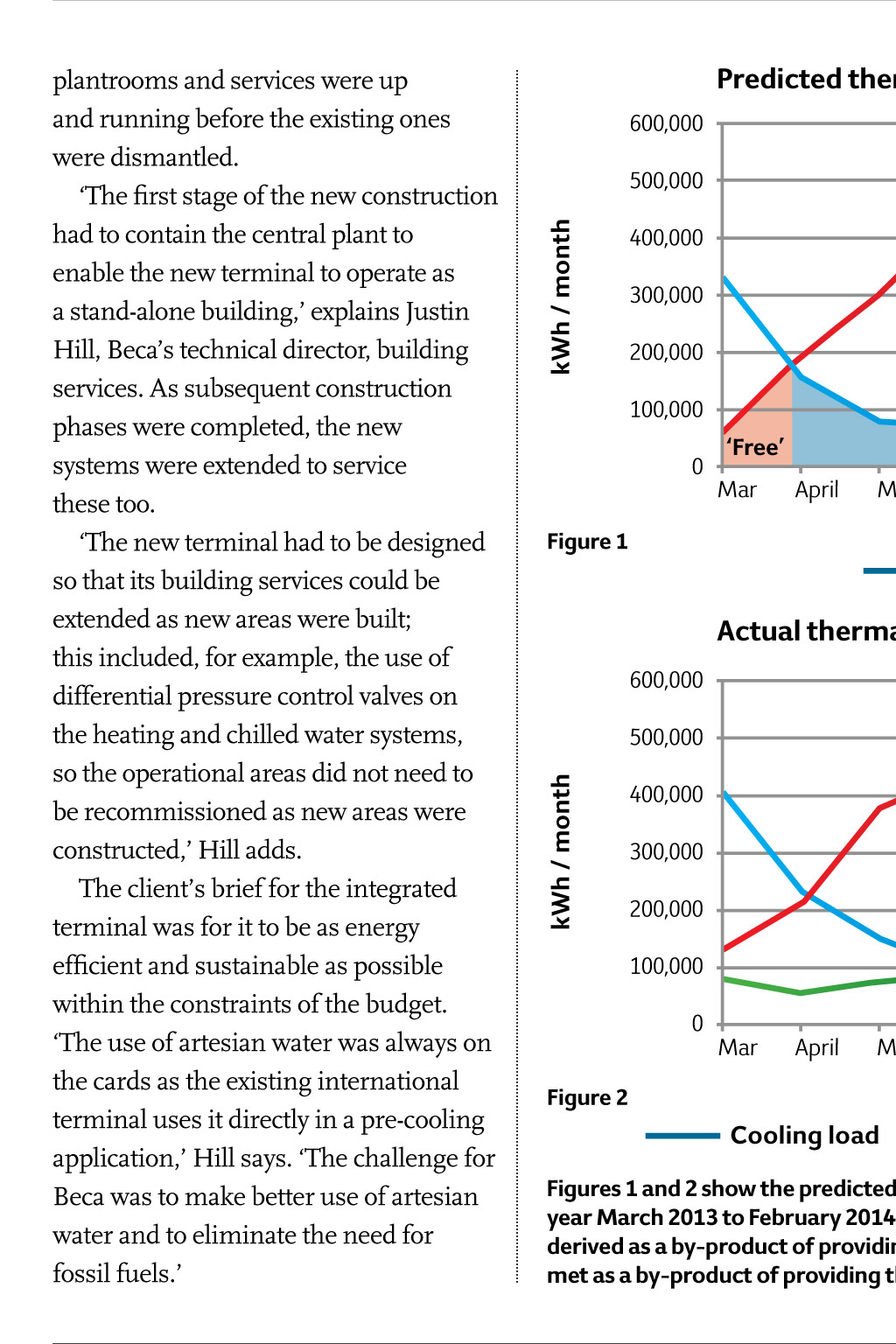
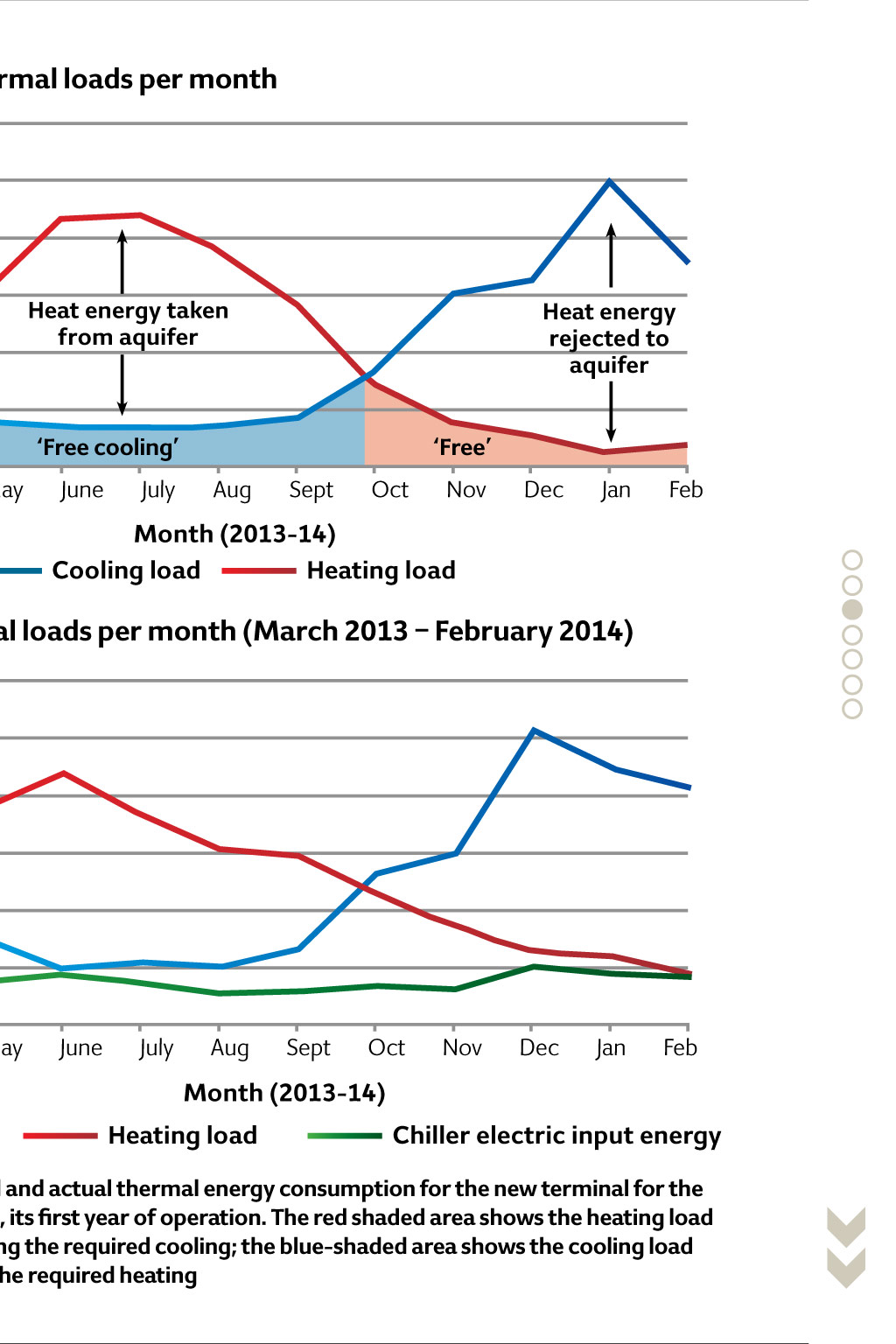
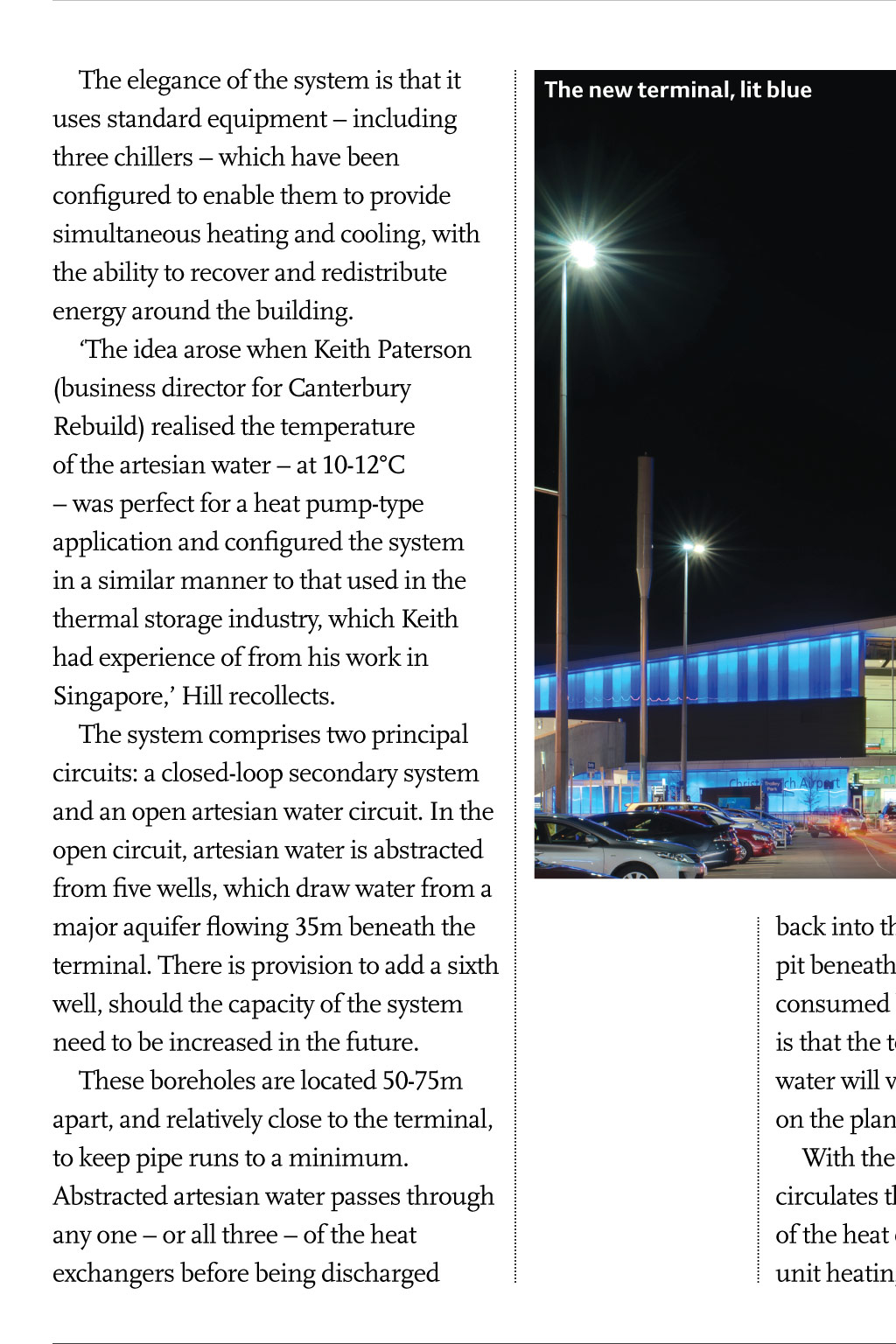
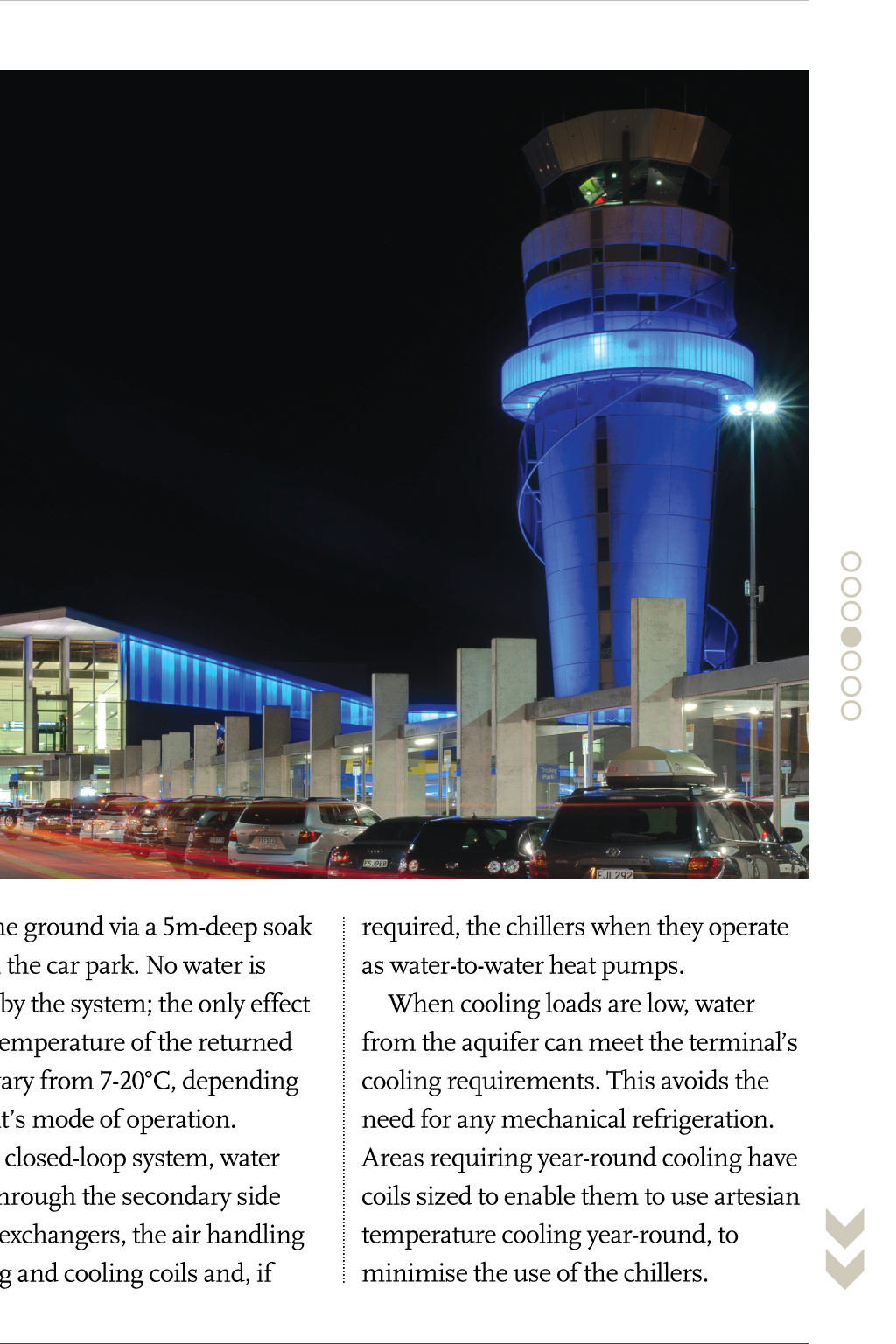
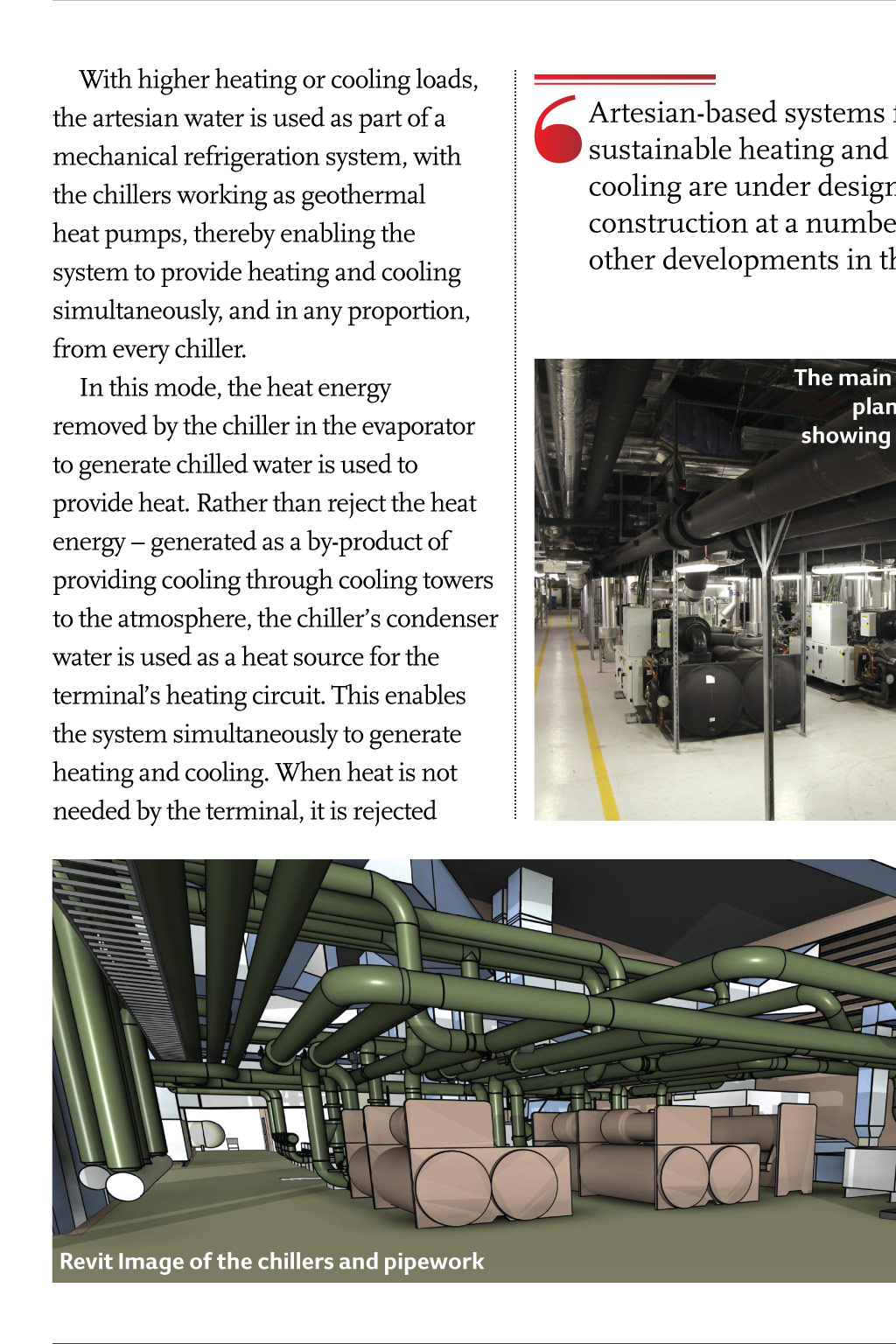
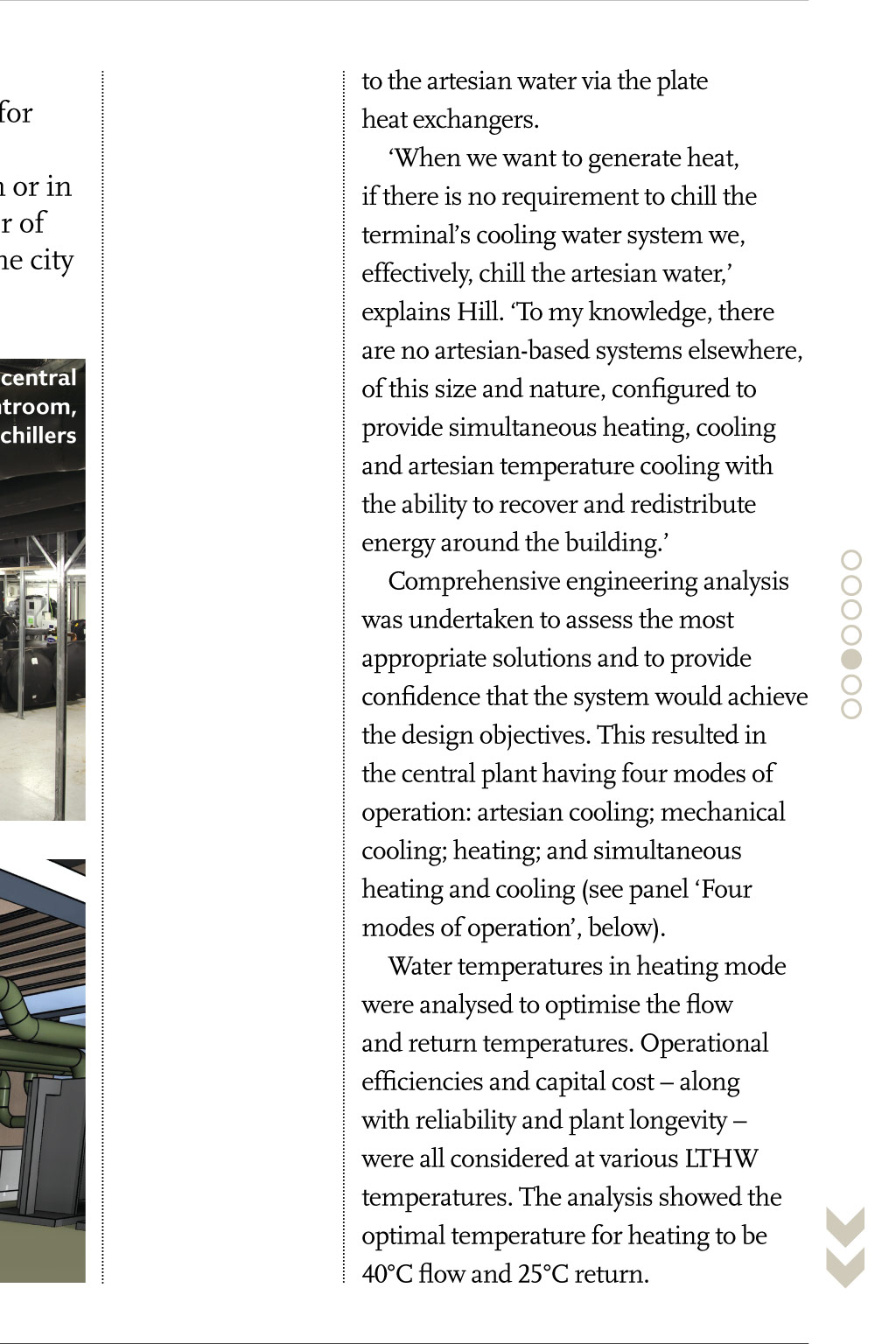

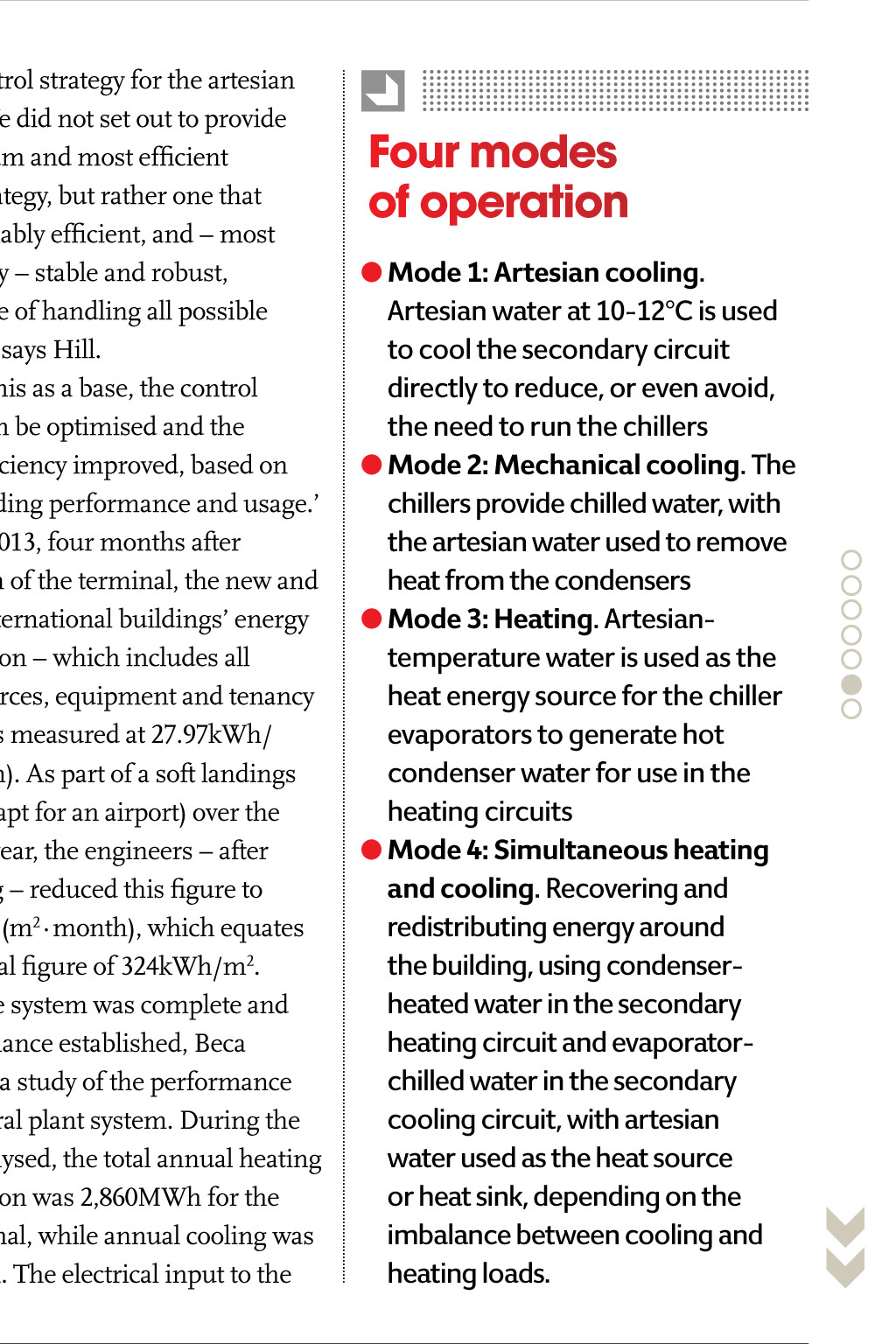
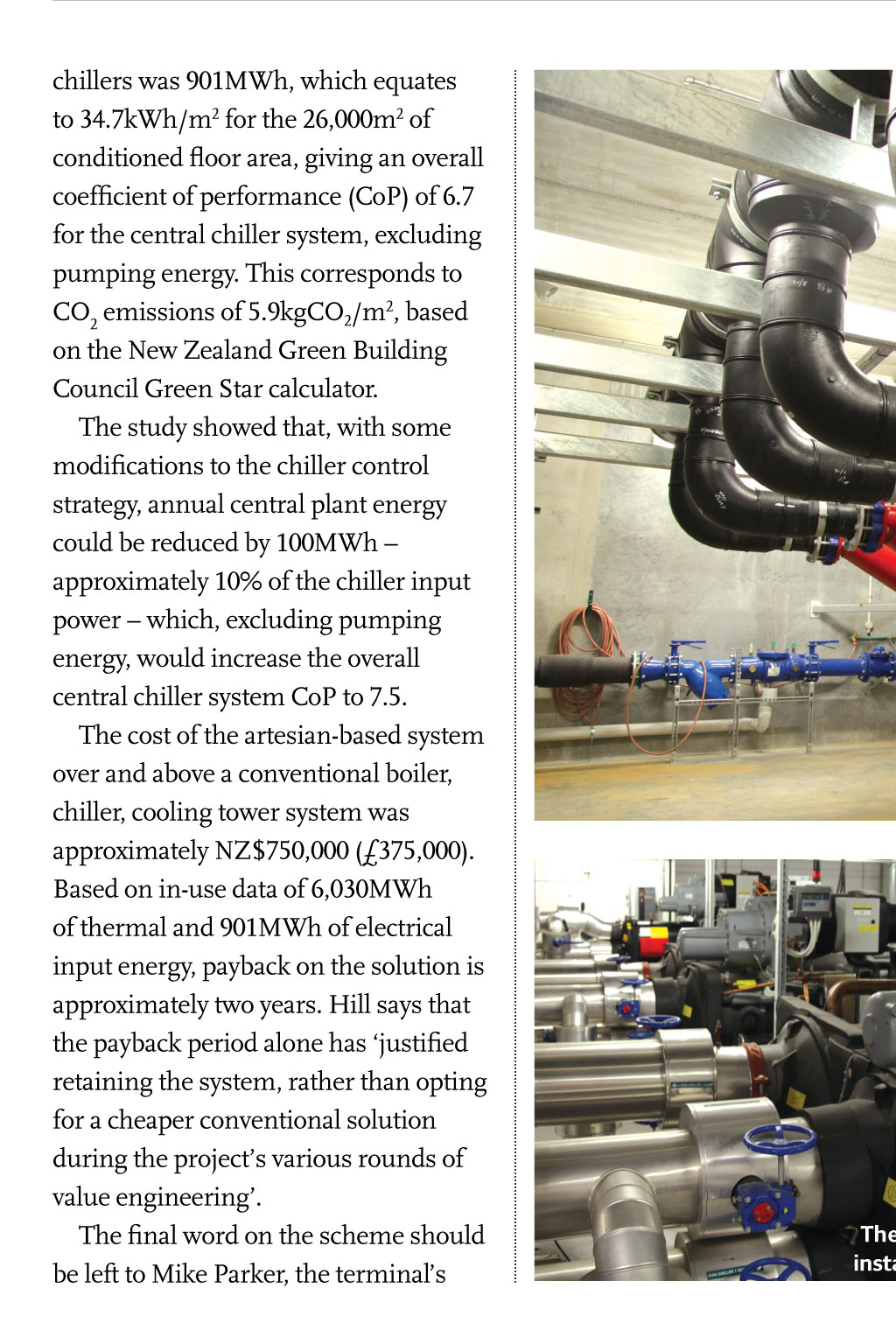
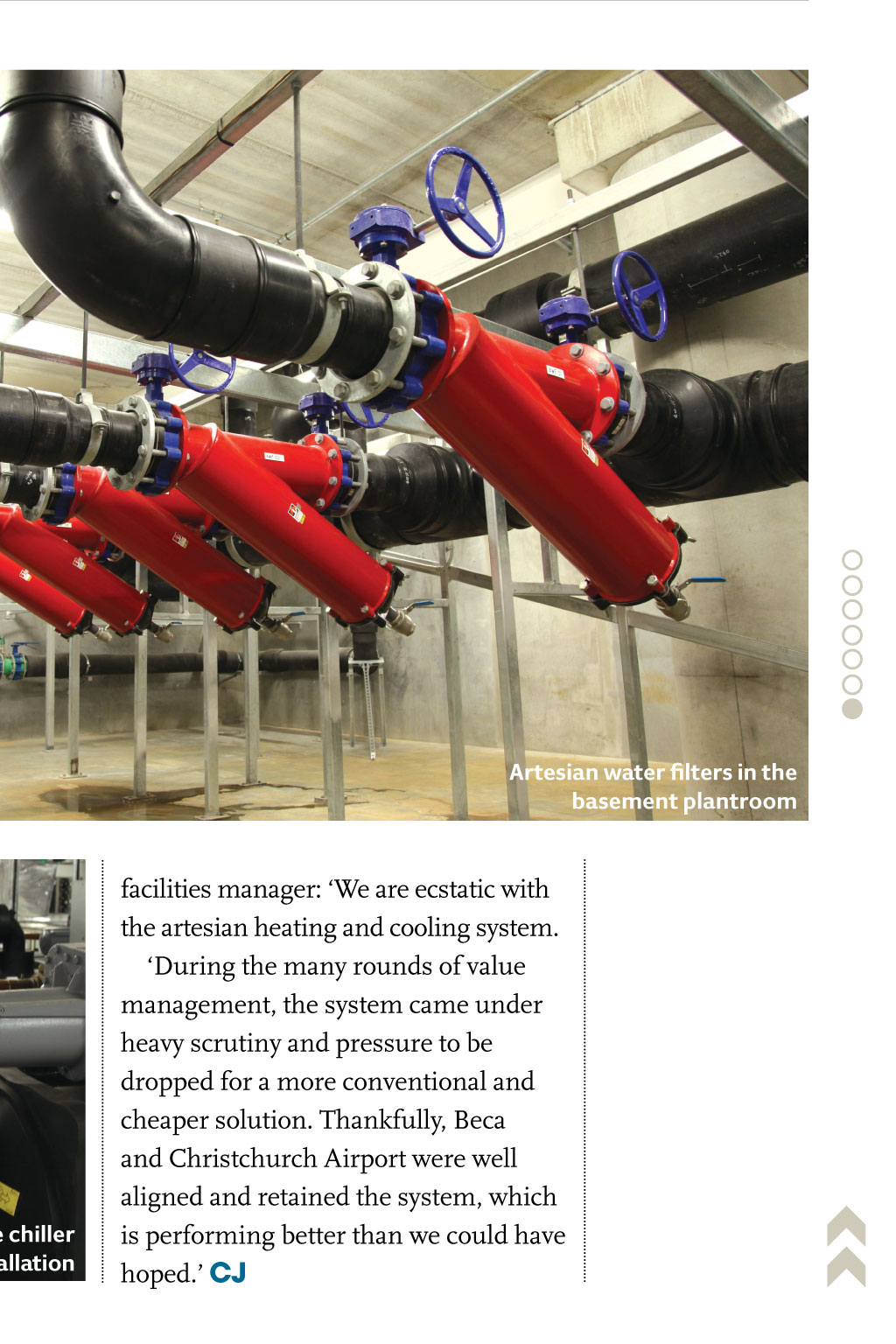















Case Study Christchurch International Airport A Flying Start Winner Christchurch International Airports new terminal features a water source heat pump system with a payback period of only two years. Andy Pearson looks at an innovative system that triumphed in the International Project of the Year category at the CIBSE Building Performance Awards 2015 eOR RMadE CALL FOR ENTRIES T Performance Awards 2015, who gave top honours to the scheme in the International Project category. They described the artesian solution as: An innovative application, with very good collaboration and strong ongoing involvement, and lots of potential for wider involvement. he new three-storey terminal at New Zealands Christchurch International Airport was the first major infrastructure project to be completed on the South Island after the devastating earthquakes of 2010 and 2011. It is fitting, then, that the 30,000m2 building relies on artesian water, abstracted from beneath the Earths surface, to provide an innovative, energy-efficient, cost-effective and environmentally benign heating and cooling solution. The artesian system was designed by the New Zealand office of multinational consultancy Beca. Since the completion and opening of the NZ$237m (121m) terminal in 2013, it has dramatically reduced the operational costs of the building and its dependency on fossil fuels. The airport operating company has been so impressed with the cost savings that it is implementing a similar artesian water-based set-up at the airports existing international terminal. The systems success is not confined to the airport; artesian arrangements for sustainable heating and cooling are under design or in construction at a number of other developments in the city. This potential legacy was recognised by the judges of the CIBSE Building The elegance of the system is that it uses standard equipment including three chillers which have been configured to enable them to provide simultaneous heating and cooling, with the ability to recover and redistribute energy around the building. The idea arose when Keith Paterson (business director for Canterbury Rebuild) realised the temperature of the artesian water at 10-12C was perfect for a heat pump-type application and configured the system in a similar manner to that used in the thermal storage industry, which Keith had experience of from his work in Singapore, Hill recollects. The system comprises two principal circuits: a closed-loop secondary system and an open artesian water circuit. In the open circuit, artesian water is abstracted from five wells, which draw water from a major aquifer flowing 35m beneath the terminal. There is provision to add a sixth well, should the capacity of the system need to be increased in the future. These boreholes are located 50-75m apart, and relatively close to the terminal, to keep pipe runs to a minimum. Abstracted artesian water passes through any one or all three of the heat exchangers before being discharged With higher heating or cooling loads, the artesian water is used as part of a mechanical refrigeration system, with the chillers working as geothermal heat pumps, thereby enabling the system to provide heating and cooling simultaneously, and in any proportion, from every chiller. In this mode, the heat energy removed by the chiller in the evaporator to generate chilled water is used to provide heat. Rather than reject the heat energy generated as a by-product of providing cooling through cooling towers to the atmosphere, the chillers condenser water is used as a heat source for the terminals heating circuit. This enables the system simultaneously to generate heating and cooling. When heat is not needed by the terminal, it is rejected The terminals integrated check-in hall Predicted thermal loads per month 600,000 kWh / month 500,000 400,000 300,000 Heat energy taken from aquifer 200,000 Heat energy rejected to aquifer 100,000 0 Free Mar Free cooling April May June July Free Aug Sept chillers was 901MWh, which equates to 34.7kWh/m2 for the 26,000m2 of conditioned floor area, giving an overall coefficient of performance (CoP) of 6.7 for the central chiller system, excluding pumping energy. This corresponds to CO2 emissions of 5.9kgCO2/m2, based on the New Zealand Green Building Council Green Star calculator. The study showed that, with some modifications to the chiller control strategy, annual central plant energy could be reduced by 100MWh approximately 10% of the chiller input power which, excluding pumping energy, would increase the overall central chiller system CoP to 7.5. The cost of the artesian-based system over and above a conventional boiler, chiller, cooling tower system was approximately NZ$750,000 (375,000). Based on in-use data of 6,030MWh of thermal and 901MWh of electrical input energy, payback on the solution is approximately two years. Hill says that the payback period alone has justified retaining the system, rather than opting for a cheaper conventional solution during the projects various rounds of value engineering. The final word on the scheme should be left to Mike Parker, the terminals Nov Dec Jan Feb Actual thermal loads per month (March 2013 February 2014) 600,000 500,000 400,000 300,000 200,000 100,000 0 Mar April May June July Aug Sept Oct Nov Dec Jan Feb Month (2013-14) Figure 2 Cooling load Heating load Chiller electric input energy Figures 1 and 2 show the predicted and actual thermal energy consumption for the new terminal for the year March 2013 to February 2014, its first year of operation. The red shaded area shows the heating load derived as a by-product of providing the required cooling; the blue-shaded area shows the cooling load met as a by-product of providing the required heating The new terminal, lit blue back into the ground via a 5m-deep soak pit beneath the car park. No water is consumed by the system; the only effect is that the temperature of the returned water will vary from 7-20C, depending on the plants mode of operation. With the closed-loop system, water circulates through the secondary side of the heat exchangers, the air handling unit heating and cooling coils and, if required, the chillers when they operate as water-to-water heat pumps. When cooling loads are low, water from the aquifer can meet the terminals cooling requirements. This avoids the need for any mechanical refrigeration. Areas requiring year-round cooling have coils sized to enable them to use artesian temperature cooling year-round, to minimise the use of the chillers. to the artesian water via the plate heat exchangers. When we want to generate heat, if there is no requirement to chill the terminals cooling water system we, effectively, chill the artesian water, explains Hill. To my knowledge, there are no artesian-based systems elsewhere, of this size and nature, configured to provide simultaneous heating, cooling and artesian temperature cooling with the ability to recover and redistribute energy around the building. Comprehensive engineering analysis was undertaken to assess the most appropriate solutions and to provide confidence that the system would achieve the design objectives. This resulted in the central plant having four modes of operation: artesian cooling; mechanical cooling; heating; and simultaneous heating and cooling (see panel Four modes of operation, below). Water temperatures in heating mode were analysed to optimise the flow and return temperatures. Operational efficiencies and capital cost along with reliability and plant longevity were all considered at various LTHW temperatures. The analysis showed the optimal temperature for heating to be 40C flow and 25C return. Artesian-based systems for sustainable heating and cooling are under design or in construction at a number of other developments in the city The main central plantroom, showing chillers Revit Image of the chillers and pipework In addition to heat from the chillers, heat is recovered from two 1MW electrical generators, when they operate, and is added to the LTHW system. The generators were installed to ensure the terminal can continue to operate in a power cut and at the request of the terminals electricity supply company to operate during periods of peak electrical demand. The chillers are more than capable of supplying sufficient heat for the building, but the heat is recovered because it is cost-effective to do so. The heating and chilled water systems have been designed with floating water temperature set-points to maximise efficiencies of the central plant. The heating water circuit flow temperature has been designed to float between 30C and 40C, depending on the heating requirement of the building. If, for example, there is a reduction in the buildings heating demand, the heating water flow temperature set-point is reduced gradually until the temperature of the heating water meets the demands of the building. This improves the efficiency of the chiller as a heat source for the building. The company spent a long time developing and bench-testing a Oct Month (2013-14) Cooling load Heating load Figure 1 kWh / month plantrooms and services were up and running before the existing ones were dismantled. The first stage of the new construction had to contain the central plant to enable the new terminal to operate as a stand-alone building, explains Justin Hill, Becas technical director, building services. As subsequent construction phases were completed, the new systems were extended to service these too. The new terminal had to be designed so that its building services could be extended as new areas were built; this included, for example, the use of differential pressure control valves on the heating and chilled water systems, so the operational areas did not need to be recommissioned as new areas were constructed, Hill adds. The clients brief for the integrated terminal was for it to be as energy efficient and sustainable as possible within the constraints of the budget. The use of artesian water was always on the cards as the existing international terminal uses it directly in a pre-cooling application, Hill says. The challenge for Beca was to make better use of artesian water and to eliminate the need for fossil fuels. The use of artesian water was always on the cards as the existing international terminal uses it directly in a pre-cooling application Justin Hill Work started on the scheme in 2005. Along with architect Warren and Mahoney, in association with Hassell (Australia), the firm designed a new terminal incorporating an integrated domestic and international checkin to sit on the site of the original 1960s domestic terminal. It was to be constructed in phases as the original terminal was progressively demolished, to make sure the airport could continue to operate. As a consequence of this phased construction, the services had to be designed to ensure the new terminals robust control strategy for the artesian system. We did not set out to provide the optimum and most efficient control strategy, but rather one that was reasonably efficient, and most importantly stable and robust, and capable of handling all possible scenarios, says Hill. Using this as a base, the control strategy can be optimised and the system efficiency improved, based on actual building performance and usage. In July 2013, four months after completion of the terminal, the new and existing international buildings energy consumption which includes all energy sources, equipment and tenancy loads was measured at 27.97kWh/ (m2month). As part of a soft landings approach (apt for an airport) over the following year, the engineers after fine-tuning reduced this figure to 27.01kWh/(m2month), which equates to an annual figure of 324kWh/m2. Once the system was complete and its performance established, Beca undertook a study of the performance of the central plant system. During the period analysed, the total annual heating consumption was 2,860MWh for the new terminal, while annual cooling was 3,170MWh. The electrical input to the four modes of operation Mode 1: Artesian cooling. Artesian water at 10-12C is used to cool the secondary circuit directly to reduce, or even avoid, the need to run the chillers Mode 2: Mechanical cooling. The chillers provide chilled water, with the artesian water used to remove heat from the condensers Mode 3: Heating. Artesiantemperature water is used as the heat energy source for thechiller evaporators to generate hot condenser water for use in the heating circuits Mode 4: Simultaneous heating and cooling. Recovering and redistributing energy around the building, using condenserheated water in the secondary heating circuit and evaporatorchilled water in the secondary cooling circuit, with artesian water used as the heat source or heat sink, depending on the imbalance between cooling and heating loads. CALL FOR ENTRIES Entries to the 2016 Building Performance Awards open on Monday 1 June and close on Thursday 10 September 2015. To receive the latest news and updates about the awards sign up to our newsletter. www.cibse.org/bpa Artesian water filters in the basement plantroom The chiller installation facilities manager: We are ecstatic with the artesian heating and cooling system. During the many rounds of value management, the system came under heavy scrutiny and pressure to be dropped for a more conventional and cheaper solution. Thankfully, Beca and Christchurch Airport were well aligned and retained the system, which is performing better than we could have hoped. cJ